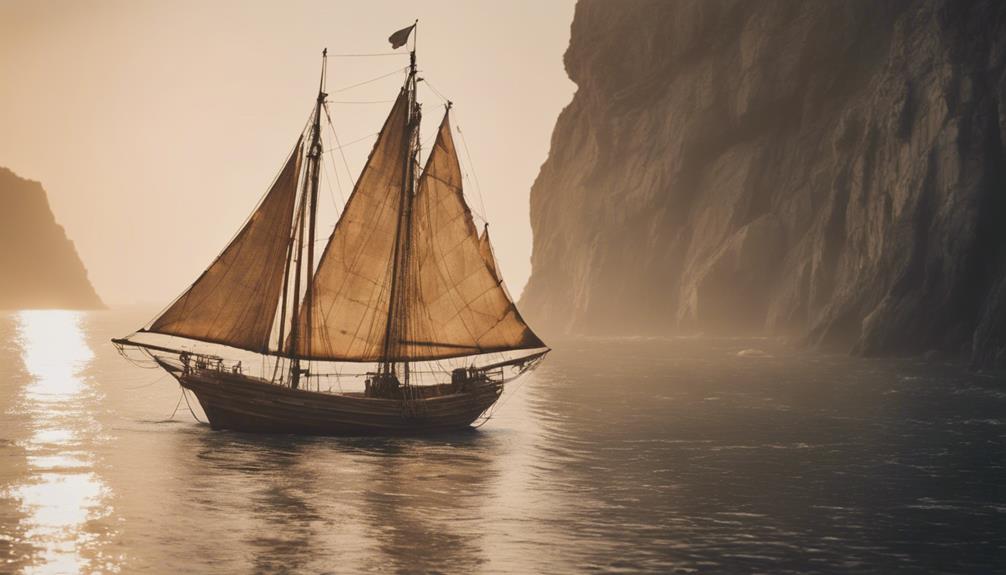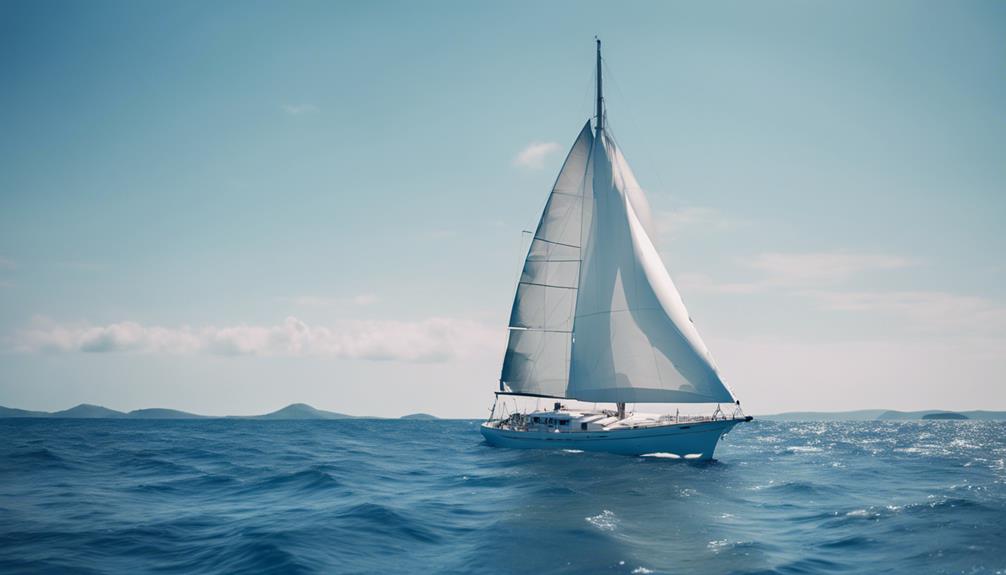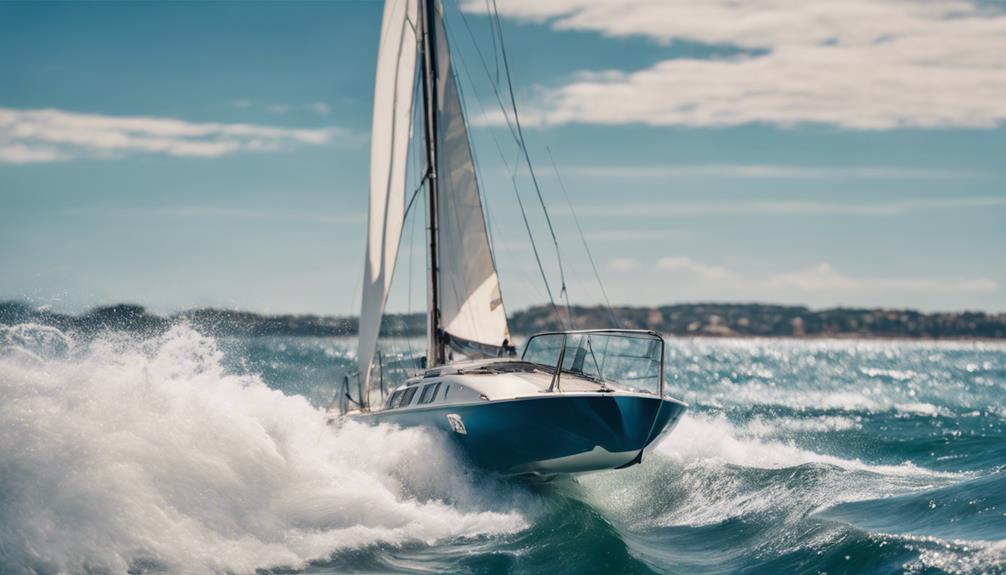If you're curious about the oldest sailboats, you'll discover a fascinating journey through maritime history. The Khufu Ship, built around 4600 years ago in ancient Egypt, stands as a proof of early shipbuilding innovation. Other notable vessels include Viking longships, which transformed trade and exploration. As you explore these historic ships, you'll find each one tells a unique story about its culture and purpose on the seas. Vessels like the USS Constitution and the Star of India also highlight the craftsmanship of their times. Keep going, and you'll uncover more about these extraordinary ships and their legacies.
Key Takeaways
- The oldest active sailing ship is the Star of India, built in 1863 and located in San Diego.
- The USS Constitution, launched in 1797, is the oldest commissioned warship and symbolizes American naval history.
- The Charles W. Morgan, built in 1841, is the last wooden whaling ship from the 19th century still in existence.
- Historic vessels like the Viking longships and Chinese junks reflect significant maritime trade and cultural exchanges throughout history.
Historical Significance of Sailboats
Sailboats have shaped our world by enabling exploration, trade, and cultural exchanges throughout history. These sailing ships haven't only traversed vast oceans but have also connected diverse cultures, fostering understanding and collaboration.
Take the Star of India, for instance. Built in 1863, it stands as the oldest active sailing ship, showcasing the enduring legacy of maritime heritage. Its preservation allows you to glimpse the technological innovations of the past while emphasizing the importance of sailing vessels in shaping global trade networks.
Throughout history, various designs have revolutionized maritime navigation. The Viking longship, with its sleek form, opened up new trade routes and exploration possibilities, while ancient Egyptian papyrus skiffs marked one of the earliest uses of wind power on the Nile.
Similarly, junks from the Han Dynasty featured sophisticated sails, enhancing trade across Asia. Each of these sailing ships played a vital role in their time, contributing to the rich tapestry of maritime history.
As you explore the significance of sailboats, you'll recognize their impact on not just navigation but the very fabric of societies worldwide.
Criteria for Inclusion

The criteria for including historic vessels hinge on their launch date, focusing on those built before 1919 and their preservation of original features during restorations.
You should note that historical significance plays a significant role in determining which ships make the cut. For instance, ships like the USS Niagara are recognized despite having undergone multiple reconstructions, as they still retain key historical components.
When evaluating originality, you can draw parallels to the Ship of Theseus paradox. Even if a ship's parts have been replaced, it may still qualify if it maintains its essential elements.
Incomplete ships, such as the Mary Rose, are reviewed based on their remains, ensuring they represent a tangible link to maritime history. However, it's essential that all included vessels have intact or partially intact hulls, as this is a fundamental requirement for inclusion.
Exclusions From the List
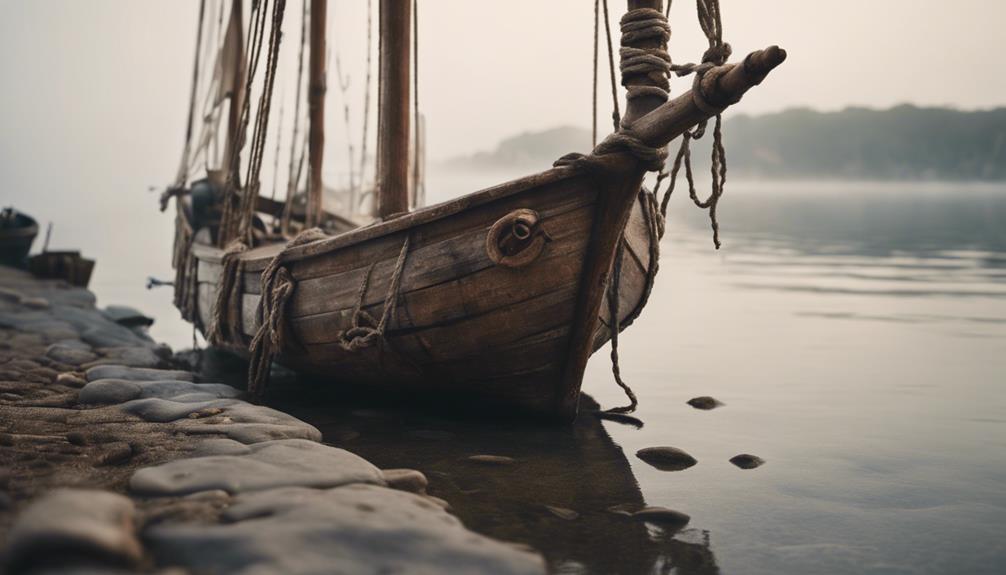
When considering which boats make the list, it's essential to recognize what gets excluded.
You won't find replicas or underwater wrecks here, as they don't fit the criteria for authenticity and preservation.
Historical context also plays a key role, ensuring that only ships with significant heritage are included.
Criteria for Inclusion
Many historic vessels don't make the list due to strict criteria that exclude replicas and underwater wrecks. To be considered among the oldest ships, a vessel must meet specific requirements, focusing on its historical significance and preservation status. This process guarantees that only genuine maritime artifacts are recognized.
Here's a table to clarify the criteria for inclusion:
| Criteria | Description | Examples |
|---|---|---|
| Launch Date | Vessels must be launched before 1919 | Mayflower, USS Constitution |
| Preservation Status | Must retain original features or remain intact | Cutty Sark, Vasa |
| Historical Significance | Must have a notable impact on maritime history | HMS Victory, Endurance |
| Reconstruction | Reconstructed ships can be included if they retain original features | USS Missouri |
Types of Excluded Ships
Various types of vessels are excluded from the list, ensuring that only authentic maritime artifacts are recognized. For instance, replicas aren't included since a separate article focuses solely on these newer constructs. The list also excludes underwater wrecks, as only ships above water are considered, emphasizing their visibility and accessibility for historical study.
Another critical exclusion involves ships launched after 1919, which means only vessels with substantial historical significance before this date make the cut. You'll also find that ships undergoing significant reconstruction face scrutiny. They can only be included if they keep original features, reflecting the complexities of preservation status.
Incomplete ships, like the Mary Rose, are acknowledged for their remains but don't qualify as fully intact vessels. This distinction is important for museums and historians, as it helps maintain the integrity of what qualifies as a historical ship.
Historical Context Considerations
Understanding the historical context of a ship is vital for determining its eligibility for inclusion in the list, especially as it influences how we perceive its authenticity and significance.
To qualify, a vessel must be launched before 1919 and retain either its original or partially intact hull. This focus guarantees that the ships in the world recognized for their historical significance genuinely reflect their contributions to maritime history.
Exclusions from historical lists include replicas, which fail to meet the criteria of originality, and underwater wrecks, which are cataloged separately. While reconstructed ships can be considered if they maintain original features, incomplete vessels like the Mary Rose are noted for their remains, highlighting their historical context despite their condition.
It's important to evaluate how a ship has played a role in sailing events and its cultural impact. This assessment allows historians and enthusiasts to appreciate the legacy of these vessels, guaranteeing that only those with true historical significance are acknowledged in the maritime narrative.
Oldest Ships Before 500 AD
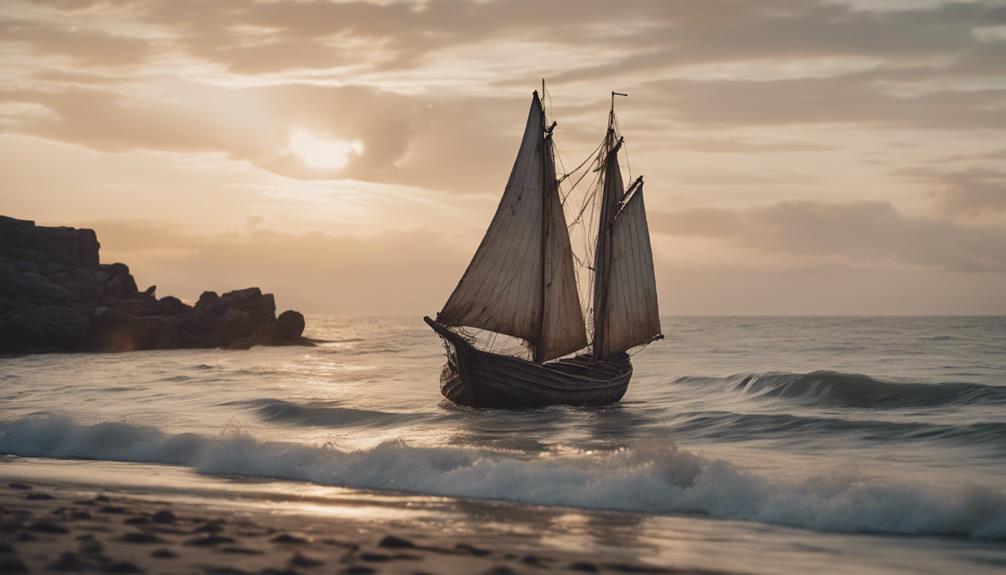
When you think about ancient ships before 500 AD, it's clear that maritime innovations played a vital role in shaping cultures.
These vessels weren't just modes of transport; they held significant cultural meaning, often tied to trade, exploration, and even religious practices.
Understanding these ships helps you appreciate how ancient societies navigated their world and interconnected with one another.
Ancient Maritime Innovations
Ancient maritime innovations laid the groundwork for seafaring, with ships like the Khufu ship and Phoenician vessels revolutionizing trade and exploration long before 500 AD. You can see how these innovations played a significant role in shaping early maritime practices.
Khufu Ship: This remarkable Egyptian vessel, built around 4600 years ago, demonstrates advanced shipbuilding techniques and is a reflection of the importance of maritime activities in ancient Egypt.
Phoenician Vessels: Known for their speed and efficiency, these ships established vital trade routes across the Mediterranean, allowing for the exchange of goods and ideas.
Maritime Trade Routes: With innovations in ship design and navigation, ancient cultures expanded their reach, enabling a network of trade that spanned vast distances.
These ancient maritime innovations not only fostered trade and exploration but also laid the foundation for future advancements in shipbuilding and navigation.
Cultural Significance of Vessels
The cultural significance of vessels like the Butuan Boat and Viking ships reveals how these ancient watercraft not only facilitated trade but also embodied the values and beliefs of the societies that created them. These vessels were essential for maritime trade, connecting different cultures and enabling the exchange of goods, ideas, and customs. For instance, the Butuan Boat, dating back to 777-988 AD, illustrates early Southeast Asian maritime networks, while Viking ships like Skuldelev 1 and Roskilde 6 highlight the Norse commitment to exploration and conquest.
Furthermore, the design innovations seen in ancient sea vessels, such as the trireme, underscore their strategic importance in naval warfare and trade routes. Ships like the Utrecht Ship showcase the advanced shipbuilding techniques of their time, reflecting a society's technological prowess and economic priorities.
Even the Khufu ship from ancient Egypt serves a dual purpose, emphasizing not just maritime trade but also the spiritual and ceremonial connections to the sea. Consequently, these vessels are more than mere transportation; they're an indication of the rich tapestry of human culture and the integral role of the sea in shaping civilizations.
Oldest Surviving Ships by Type

Exploring the oldest surviving ships reveals a fascinating array of maritime history, showcasing vessels that have stood the test of time across various categories. Importantly, these ships offer a glimpse into the evolution of seafaring and the craftsmanship of their eras.
The Star of India, built in 1863, holds the title of the oldest active sailing ship in the world, currently residing in San Diego, California.
The USS Constitution, launched in 1797, remains the oldest commissioned warship afloat and is a cherished symbol of American naval history.
The Charles W. Morgan, constructed in 1841, is the last surviving wooden whaling ship from the 19th century, serving as an educational tool for maritime heritage.
Each of these vessels not only represents a specific type of ship but also carries stories of adventure, trade, and naval warfare.
By visiting these historic ships, you can immerse yourself in the maritime past and appreciate the craftsmanship and resilience that have allowed them to endure through the centuries.
Whether you're drawn to the romance of the sea or the intricacies of shipbuilding, exploring these oldest surviving ships offers an enriching experience.
Notable Restoration Efforts
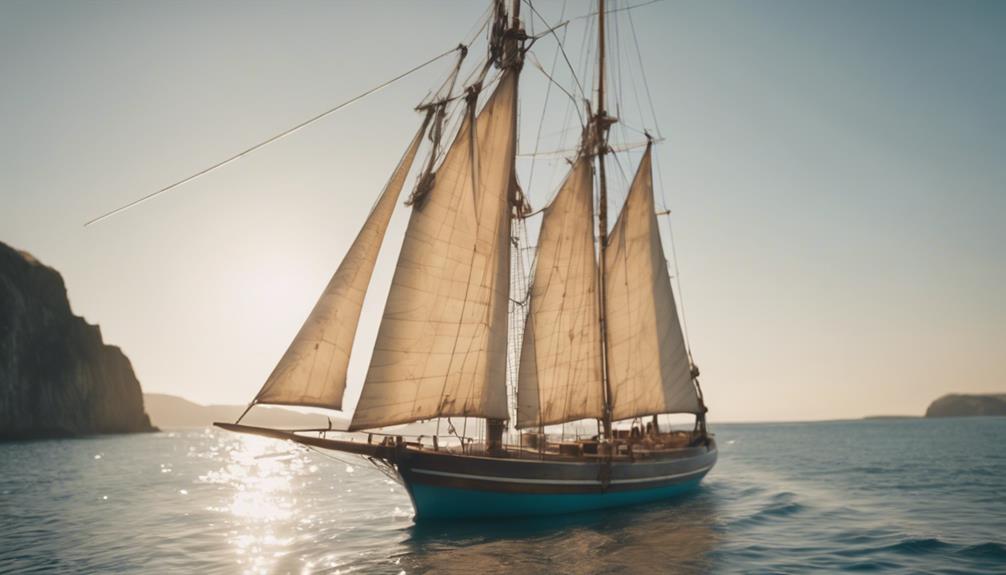
Notable restoration efforts breathe new life into historic vessels, ensuring that their rich maritime stories continue to be told for generations to come. These projects not only preserve the ships themselves but also the cultural heritage they represent. For instance, the James Craig, a three-masted barque, underwent over two decades of restoration at the Sydney Maritime Museum, returning to operational status in 2001. Similarly, the USS Constitution, the oldest commissioned warship afloat, remains an active sailing ship thanks to its major restoration in the 1990s.
Here's a quick overview of some notable restoration efforts:
| Vessel | Year of Restoration | Current Status |
|---|---|---|
| James Craig | 1972-2001 | Operational at Sydney Museum |
| USS Constitution | 1990s | Active sailing symbol |
| Star of India | 1962-1976 | Sails annually as Living History |
| Charles W. Morgan | 2014 | Engages in educational outreach |
| Historic Vessels | Ongoing | Supported by donations & grants |
These restorations highlight the importance of community involvement in preserving our maritime heritage.
Visitor Experience at Maritime Museums

Engaging with maritime museums offers a unique opportunity to immerse oneself in the rich history and culture of seafaring through interactive exhibits and hands-on experiences. At places like the San Diego Maritime Museum, you can explore iconic ships still sailing today, such as the Star of India. These experiences not only educate but also connect you with maritime heritage.
- Participate in sailing activities and living history programs.
- Enjoy family-oriented events like cannon demonstrations and rowing lessons.
The visitor experience at maritime museums is designed to be engaging and educational, making history come alive. Whether you're climbing aboard a historic vessel or listening to tales of the sea, each moment enhances your understanding of maritime traditions.
Plus, the interactive nature of these museums encourages visitors of all ages to dive deeper into the past. So, whether you're a history buff or just looking for a fun day out, maritime museums provide unforgettable experiences that celebrate the art of sailing and the stories of those who sailed before us.
Cultural Impact of Historical Vessels

Historical vessels profoundly shape our understanding of maritime culture and highlight the technological advancements that have influenced global trade and exploration throughout the ages. Each ship, like the Star of India or the Viking longship, serves as a tangible link to our maritime heritage, showcasing the evolution of sailing technology and trade practices.
These vessels not only tell stories of past adventures but also reflect the cultural significance of seafaring traditions across different societies. For instance, the Chinese junks of the Ming Dynasty demonstrated advanced maritime capabilities that reshaped global trade routes in the 15th century.
Meanwhile, the tragic sinking of the RMS Titanic underscored the importance of safety regulations, prompting reforms that transformed ship design worldwide.
Preserving and restoring vessels like the Charles W. Morgan honors this rich maritime history, allowing you to engage with and learn from the past. By exploring these historical vessels, you gain insight into the interconnectedness of cultures, economies, and innovations that have shaped our world.
Ultimately, they remind us of the profound impact of the sea on human civilization and the legacies we continue to build upon today.
Frequently Asked Questions
What Is the Oldest Sailing Ship Still Seaworthy?
The oldest sailing ship still seaworthy is the Star of India, built in 1863. You'll find it at the San Diego Maritime Museum, where it actively participates in sailing events and educational programs.
What Is the Oldest Ship Still in Existence?
If you thought your grandma's antique vase was old, wait 'til you hear about the oldest ship still afloat! It's the USS Constitution, launched in 1797, proudly representing maritime history while still ready to battle.
What Was the Earliest Vessel Sailing?
The earliest known vessels, like those used by ancient Egyptians, relied on simple sails and wind power. You'll find these ancient skiffs emerged around 3000 BC, revolutionizing travel and trade across rivers and seas.
What Is the Oldest Fully Rigged Ship in the World?
Imagine a majestic ship, gracefully dancing upon waves. The oldest fully rigged ship in the world is the Star of India, built in 1863. She's still sailing, embracing history while enchanting hearts.
What Makes Historical Vessels the Oldest Sail Boat?
Historical vessels become the oldest sail boats due to their significant role in maritime history. These long-standing artifacts have stood the test of time and continue to be celebrated as the longest sail boat world record holders. Their enduring legacy showcases the rich heritage and craftsmanship of ancient seafaring cultures.
Conclusion
As you sail through the fascinating history of these ancient vessels, you can't help but appreciate their lasting impact on maritime culture.
From the oldest ships before 500 AD to the remarkable restoration efforts, these boats tell tales that bridge centuries.
Visiting maritime museums lets you dive deep into this rich heritage, reminding you that every ship has a story to share.
So, hoist your sails and begin a journey through time—you won't regret it!

